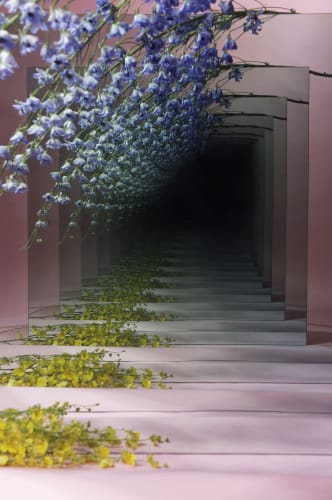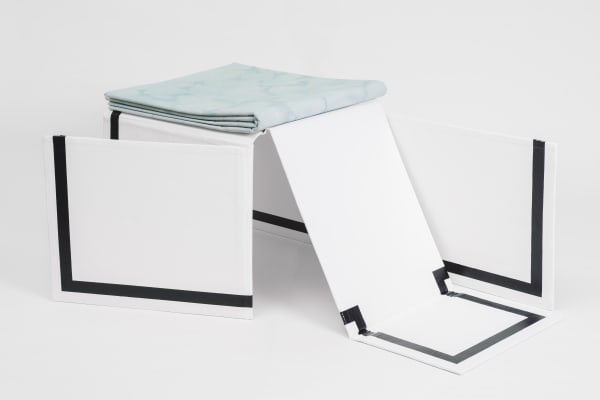Escape Attempts
Carmen Argote, Susan Hefuna, Cindy Hinant, Alex McQuilkin, Sarah Meyohas, Virginia Overton, and Naama Tsabar
Inaugurating its new Hollywood location, Shulamit Nazarian presents Escape Attempts, a group exhibition of seven international artists working in dialogue with the legacy of minimal art. Carmen Argote, Susan Hefuna, Cindy Hinant, Alex McQuilkin, Sarah Meyohas, Virginia Overton, and Naama Tsabar present work that both acknowledges and subverts the practice of their predominately male forebears including Sol Lewitt, Donald Judd, and Larry Bell.
The artists in Escape Attempts employ the formal elements associated with Minimalism. Reduced color palettes and the repetition of simple geometric forms, as well as industrial materials that have a symbiotic relationship to architecture, create new mash-ups that mix formal rigor with sensuality, subjectivity, personal narrative, and contemporary sexual politics.
Escape Attempts pays homage to a 1972 essay by writer, curator, and activist Lucy Lippard. Her essay points to the particular climate of the late 1960s and early 1970s in which artists grappled with central issues of civil rights, gender politics, and anti-war movements—battles that are still questioned and debated today. Like the artists in Lippard’s essay who defied the hegemony of their Abstract Expressionist predecessors, the artists in this exhibition look both to the past and the future, engaging a vocabulary of cultural references unique to this era.
Carmen Argote’s work explores memory and architecture from a personal and political perspective. For the exhibition, Argote has created a new series of monochromatic sculptures that echo formal qualities found in architectural floor plans and domestic structures used for folding laundry. In a similar manner, Susan Hefuna’s drawings and sculptures appropriate the ubiquitous mashrabiya screens that divide public and private space in North African and Middle Eastern households. Hefuna recreates the latticed patterns of the screens by transforming hand-drawn images into cast bronze, creating new forms that represent the bifurcation between male and female domains. Cindy Hinant acknowledges the utopian space of Minimalism by simultaneously embracing and subverting the monochrome and grid in her work. Exploring what she calls “an aesthetics of violation,” Hinant riffs on the commodification of female sexuality seen in celebrity gossip magazines and sex tapes proliferated in popular culture. Alex McQuilkin’s paintings incorporate wallpaper motifs from 1980s suburban America, where Laura Ashley and Ralph Lauren were seen as de rigeur for the upper-middle class. Expanding the grid pattern with duplicated forms, McQuilkin works in handspun intimacy and nods to the pink palette of girlish teenage bedrooms. Sarah Meyohas presents large-scale photographs from her Speculations series, in which mirrors and constructed props in the artist’s studio suggest infinite cubic forms. In line with her earlier bodies of work, such as BITCHCOIN and Stock Performance, these pieces interrogate the rules of aesthetics and market value alongside the artist’s role within such spheres. Virginia Overton’s work demonstrates an abiding interest in reclaimed mass-market materials, including lumber planks, doors, shelves, and industrial lighting. Wryly combining objects found in everyday life, her sculptures investigate platonic forms such as circles and squares, reconfiguring them in arrangements that are at once familiar and strange. Naama Tsabar’s sculptures reference minimal structures, most notably Robert Morris’ felt works from the late 1960s and early 1970s; Tsabar’s objects, however, double as instruments to be played by the artist and fellow musicians during live gallery events. The sculptures, charged as artifacts from the artist’s performance, remain on display throughout the exhibition. The artists in the show consider their vexed relationship to minimal art and present a decidedly new engagement with the simplicity of form. Far from the industrial, unemotional sculpture associated with their male precursors, Escape Attempts embraces the subjective and revels in a self-consciously intimate approach to art making. Escape Attempts is organized by New York-based writer and curator Kathy Battista. The exhibition derives from a chapter in her forthcoming book New York New Wave: The Legacy of Feminist Art in Emerging Practice, to be published by IB Tauris in Summer 2017. Naama Tsabar will present a performance on opening night, February 18, at 8pm.
-
 Carmen Argote, Folding Structure (pool), 2016
Carmen Argote, Folding Structure (pool), 2016 -
 Susan Hefuna, Grid Drawing, 2015
Susan Hefuna, Grid Drawing, 2015 -
 Cindy Hinant, Upskirt (Lindsay), 2016
Cindy Hinant, Upskirt (Lindsay), 2016 -
 Alex McQuilkin, Untitled (For Corinne), 2016
Alex McQuilkin, Untitled (For Corinne), 2016 -
 Sarah Meyohas, Speculation, 2015
Sarah Meyohas, Speculation, 2015 -
 Virgina Overton, Untitled (orb), 2016
Virgina Overton, Untitled (orb), 2016 -
 Naama Tsabar, Work on Felt (Variation 9) Bordeaux, 2016
Naama Tsabar, Work on Felt (Variation 9) Bordeaux, 2016 -
 NAAMA TSABAR, Work on Felt (Variation 10) Black, 2016
NAAMA TSABAR, Work on Felt (Variation 10) Black, 2016 -
 NAAMA TSABAR, Closer, 2014
NAAMA TSABAR, Closer, 2014



















